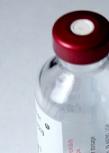Advertisment
While person with Type-1 diabetes sleeps, instruments can detect low blood sugar-and stop insulin

by Bruce Sylvester – Using ordinary instrumentation plus a computer during nocturnal insulin delivery, scientists have found a method to predict and prevent dangerously low overnight blood sugars in adolescents and adults with type-1 diabetes.
The new study was online on May 7 in Diabetes Care.
“A system like this should dramatically decrease diabetics’ risk of having a seizure overnight,” said lead investigator Bruce Buckingham, MD, professor of pediatric endocrinology at Stanford. “Patients and parents will be able to have a better night’s sleep, knowing that there is a much lower risk of severe hypoglcyemia at night.”
As background, the authors noted that very low blood-sugar levels can cause seizures, even death. And 75 percent of diabetic seizures happen during sleep.
The investigators used a sub-dermal glucose sensor and an insulin pump connected wirelessly to a bedside computer. The computer calculates an event of impending hypoglycemia and temporarily suspends insulin delivery until the sugar level trends upward. The sleeping patient remains undisturbed.
The investigators enrolled 45 subjects, ages 15-45, with type-1 diabetes. Each person participated for about 42 nights, for a total of 1,912 patient-nights. The patients slept in their own homes.
Each night, the algorithm on the computer was randomized to be active or inactive. On active nights, the computer continuously predicted whether blood sugar would fall below 80 milligrams per deciliter in the next 30 minutes, slightly above the 60 mg/dl level at which complications of hypoglycemia begin to appear. If the computer predicted a “low,” the insulin pump was automatically stopped until blood sugar increased.
The researchers found that shutoffs reduced cumulative nocturnal low blood sugar by 81 percent, with a small increase in nighttime glucose levels.
The authors noted that insulin pumps were stopped at least once during 76 percent of the treatment nights, and the length of low blood sugar episodes lasting two hours or more was cut by 74 percent.
In the mornings after treatment nights, median blood glucose was slightly increased, but was within safe range.
The research team is now investigating the technique with a wider age group, including children ages 3-15. “A lot of parents whose children have diabetes are getting up night after night at midnight and 3 a.m. to check their children’s blood-sugar levels,” Buckingham said. “We think this type of system is going to make it much easier for them to feel comfortable about letting their child with diabetes sleep through the night with fewer overnight sugar tests. Parents will be able to get a better night’s sleep, too.”





